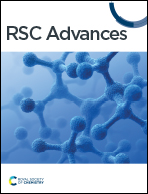Novel supramolecular luminescent metallogels containing Tb(iii) and Eu(iii) ions with benzene-1,3,5-tricarboxylic acid gelator: advancing semiconductor applications in microelectronic devices†
Abstract
A novel strategy was employed to create supramolecular metallogels incorporating Tb(III) and Eu(III) ions using benzene-1,3,5-tricarboxylic acid (TA) as a gelator in N,N-dimethylformamide (DMF). Rheological analysis demonstrated their mechanical robustness under varying stress levels and angular frequencies. FESEM imaging revealed a flake-like hierarchical network for Tb–TA and a rod-shaped architecture for Eu–TA. EDX analysis confirmed essential chemical constituents within the metallogels. FT-IR, PXRD, Raman spectroscopy, and thermogravimetric analysis assessed their gelation process and material properties, showing semiconducting characteristics, validated by optical band-gap measurements. Metal–semiconductor junction-based devices integrating Al metal with Tb(III)- and Eu(III)-metallogels exhibited non-linear charge transport akin to a Schottky diode, indicating potential for advanced electronic device development. Direct utilization of benzene-1,3,5-tricarboxylic acid and Tb(III)/Eu(III) sources underscores their suitability as semiconducting materials for device fabrication. This study explores the versatile applications of Tb–TA and Eu–TA metallogels, offering insights for material science researchers.



 Please wait while we load your content...
Please wait while we load your content...